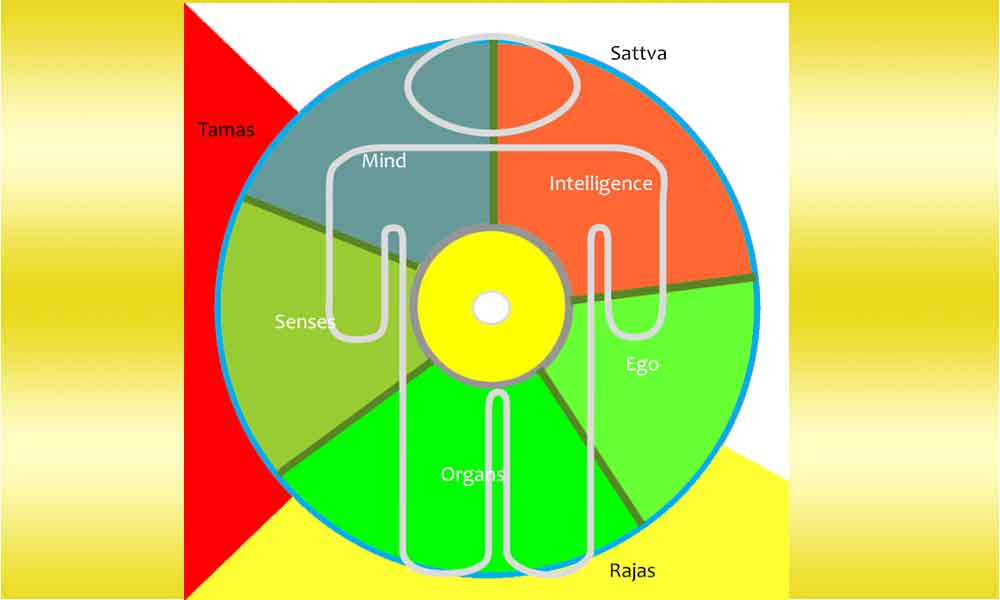
The Self and the Not-Self

Notes: I have translated the Bhagavadgita twice. The first one was a loose translation. The second one was a word to word translation with a detailed commentary. The commentary is however different from what you will find here. In this section I will share with you my thoughts about the knowledge, philosophy and wisdom of the Bhagavadgita as I understand it from my perspective. Jayaram V
What is the difference between you and me? If you ask me, "Who are you?" I will reply, "I am Jayaram." If I ask you, "Who are you?" you will reply, "I am so and so." What is common between both of us? I AM. This "I-AM" is universal. It exists in everyone. It exists in the seven billion people who live upon earth. It exists in every living being, even if they are not conscious of it. Same in everyone, it lives in each according to the deeds.
What creates the difference and the diversity is the latter part, the individuality. Jayaram is the individuality, or the ego. It is the outer clothing, which "I-AM" wears. It makes everyone different, separate and recognizable. This individuality is the corrupting, restricting, and binding aspect of "I-AM." It makes living a conscious experience in the midst of the objective world. "I-AM" never dies. It has no death.
The center is the same in all of us. However, what is built around it is different in every living being. It is made up of different qualities (gunas), components (tattva) and organs (indriyas). This part is transient, and will die eventually. It is subject to aging, sickness and death. Will it be reborn? No, it will not. It lives, but one life, and in that one life it tries to make the most of it and desires to live forever.
It is the reflection of "I-AM" in the qualities of Nature. It is the other bird on the tree of life, which wants to eat the fruit, while the other watches. Whether it is in me or in you, the "I-AM" is indistinguishable. When you practice yoga and enter the deepest part of your consciousness, you silence your individuality or personality and become "I-AM" When I-AM alone exists without a second, you enter the purest state of consciousness and become liberated.
Suggestions for Further Reading
- The Wisdom of the Bhagavadgita, Main Page
- The Wisdom of the Upanishads, Main Page
- The Bhagavad-Gita Essays and Translations
- An Introduction To The Bhagavad-Gita And Its Three Secrets
- Why to Study the Bhagavadgita Parts 1 to 4
- The Abbreviated Bhagavadgita
- The Problem of Maya Or Illusion and How To Deal With It
- The Problem of Maya Or Illusion and How To Deal With It
- The Bhagavadgita, Philosophy and Concepts
- The Many Gods and Goddesses of Hinduism
- Divine Qualities Of A True Worshipper Of God
- The Bhagavadgita on Karma, the Law of Actions
- Maya, The Grand Illusion Or The Delusion Of The Mind
- Aspects, Emanations, Incarnations and Forms of God Vishnu
- Dvaita or Advaita What is the Truth?
- Symbolism in the Bhagavadgita
- The Truth About Karma
- Meaning and Definition of Bhagavan
- Brahman the Supreme Universal Lord of All
- What is Bhakti or Devotion?
- Bhakti Marg, the Path of Devotion
- History and information about Mathura and Vrindavan Temples
- True Devotion and Qualities of a True Devotee
- Essays On Sorrow And Its Spiritual Significance
- The Yoga of Knowledge or the Samkhya Yoga, Verses and Commnetary by Jayaram V
- Essays On Dharma
- Esoteric Mystic Hinduism
- Introduction to Hinduism
- Hindu Way of Life
- Essays On Karma
- Hindu Rites and Rituals
- The Origin of The Sanskrit Language
- Symbolism in Hinduism
- Essays on The Upanishads
- Concepts of Hinduism
- Essays on Atman
- Hindu Festivals
- Spiritual Practice
- Right Living
- Yoga of Sorrow
- Happiness
- Mental Health
- Concepts of Buddhism
- General Essays